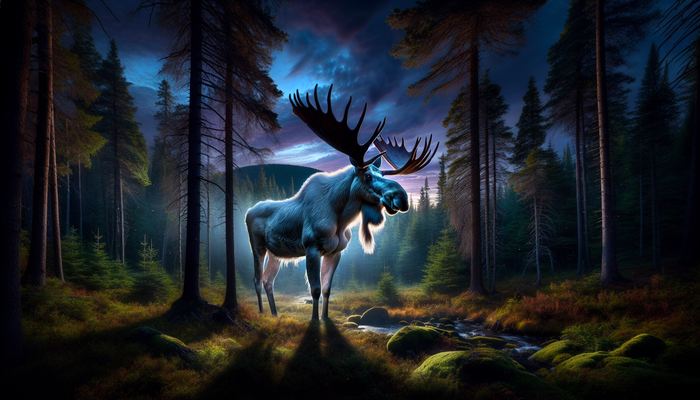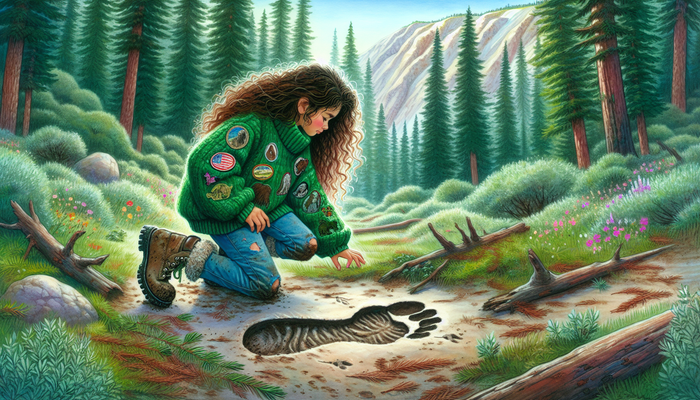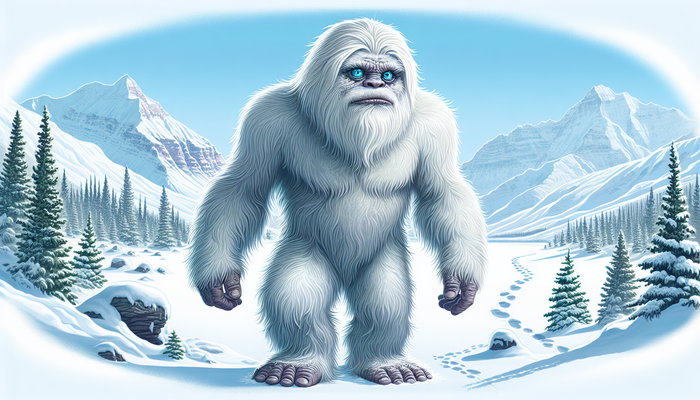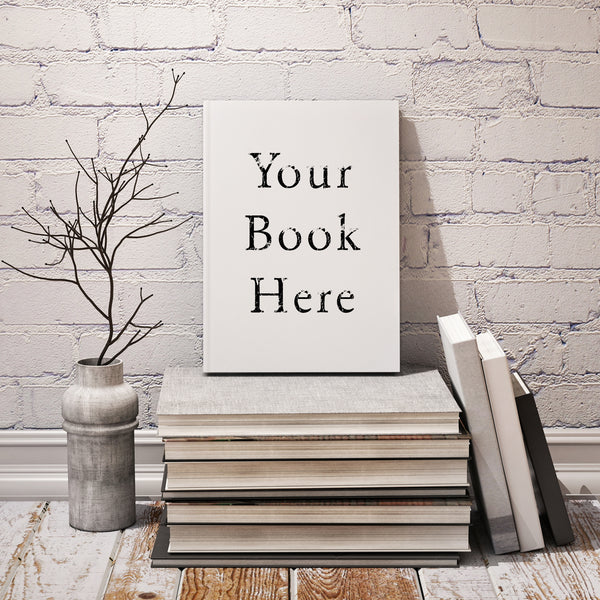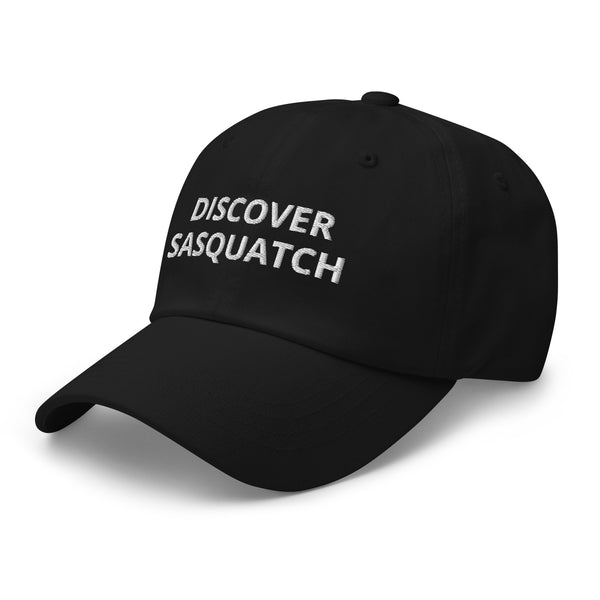Discover the Mystical Hawaii Menehune: Legends and Lore

By Wade Beaumont, Cryptozoologist
The Menehune: Masters of the Night
Picture, if you will, a moonlit night on the island of Kauai. The air is thick with the scent of plumeria, and the only sounds are the gentle lapping of waves and the distant call of a night bird. Suddenly, a flurry of activity breaks the stillness. Tiny figures, no taller than a child, move with incredible speed and precision, their muscular forms barely visible in the shadows. These are the Menehune, and they're about to perform one of their legendary feats of construction.
According to Hawaiian lore, the Menehune stand between two to three feet tall, with dark skin that allows them to blend seamlessly into the night. Their most striking features are their large, expressive eyes, often hidden beneath bushy eyebrows that give them an air of mystery and wisdom. But don't let their small stature fool you – these little folks are said to possess strength that rivals giants and a work ethic that would put the most industrious humans to shame.
The Menehune are nocturnal creatures, shunning the light of day and emerging only when the sun dips below the horizon. Their aversion to daylight isn't just a quirk; it's a crucial part of their mystique. Legend has it that if a Menehune is caught in the act of working or spotted by human eyes, they'll abandon their project immediately, never to return. This peculiarity has given rise to the saying, "Work like the Menehune," meaning to complete a task swiftly and under the cover of darkness.
But the Menehune aren't just strong and stealthy; they're also incredibly skilled craftsmen. Their expertise spans a wide range of disciplines, from stone masonry and woodworking to irrigation and agriculture. The structures attributed to the Menehune are marvels of engineering, often completed in a single night and with a level of precision that baffles modern observers.
One of the most fascinating aspects of Menehune lore is their supposed magical abilities. Some stories claim they can turn invisible at will, allowing them to move unseen among humans. Others speak of their prowess with a bow and arrow, not for hunting, but for a far more whimsical purpose. It's said that Menehune arrows, when shot into the heart of an angry person, have the power to transform rage into love. Imagine a world where conflicts could be resolved with a single, well-placed arrow of aloha!
The Cultural Tapestry of the Menehune
The Menehune aren't just characters in a fairy tale; they're woven into the very fabric of Hawaiian culture. These little people embody values that are central to the Hawaiian way of life: hard work, community cooperation, respect for nature, and the importance of maintaining harmony with the environment.
In many ways, the Menehune serve as a bridge between the ancient and modern worlds of Hawaii. Their stories, passed down through generations, keep alive the traditions and wisdom of the past. When a Hawaiian elder tells a child about the Menehune building a fishpond in a single night, they're not just sharing a fanciful tale. They're imparting lessons about the importance of working together, the value of skill and craftsmanship, and the power of believing in something greater than oneself.
The Menehune also play a crucial role in fostering a sense of place and belonging among Hawaiians. In a world where globalization often threatens to erode local cultures, the Menehune stand as proud symbols of Hawaii's unique heritage. Their presence in stories and legends reminds Hawaiians of their deep connection to the land and its history.
But the cultural significance of the Menehune goes beyond mere symbolism. These legendary beings often feature in moral tales, teaching important lessons to young and old alike. For example, the story of the Alekoko Fishpond, which we'll explore in more detail later, serves as a cautionary tale about the consequences of curiosity and disobedience. By weaving moral lessons into entertaining stories about the Menehune, Hawaiian culture ensures that important values are passed down in a way that's both memorable and engaging.
The Menehune also embody the Hawaiian concept of "malama 'aina," or caring for the land. Their nocturnal nature and ability to work in harmony with their surroundings reflect the Hawaiian belief in the importance of living in balance with nature. In a time when environmental concerns are more pressing than ever, the Menehune serve as a powerful reminder of our responsibility to protect and nurture the natural world.
Tracing the Origins of the Menehune Legend
The origins of the Menehune legend are as complex and intriguing as the little people themselves. To understand where these stories came from, we need to dive into the murky waters of Hawaiian history, where fact and fiction often swirl together in a captivating dance.
One prevailing theory suggests that the term "Menehune" is derived from the Tahitian word "manahune," which refers to commoners or people of a lower social class. This linguistic connection hints at a fascinating historical possibility: could the Menehune legend be rooted in the actual history of Hawaii's early settlers?
Some scholars propose that the Menehune were, in fact, the first wave of Polynesian settlers to reach Hawaii, possibly from the Marquesas Islands. These early arrivals may have been shorter in stature than the later Tahitian settlers, leading to their depiction as small people in legend. When the taller, more powerful Tahitians arrived, they may have pushed the original inhabitants into the mountains and forests, where they became the stuff of myth and legend.
This theory gains some credibility from an intriguing historical document: the 1820 census conducted by King Kaumualiʻi of Kauai. This census, believe it or not, listed 65 individuals as "Menehune." It's a tantalizing piece of evidence that suggests the Menehune may have been more than just mythical beings, at least in the minds of some 19th-century Hawaiians.
But here's where things get really interesting. The first written accounts of the Menehune as we know them today – small, magical beings with incredible building skills – didn't appear until the late 19th and early 20th centuries. This was a time when Hawaii was undergoing rapid change, with increasing influence from Western culture.
Some researchers argue that the modern conception of the Menehune was shaped by this cultural collision. As Hawaiian oral traditions met European fairy tales, the Menehune may have taken on characteristics of Old World magical creatures like leprechauns or elves. It's a fascinating example of how myths can evolve and adapt over time, blending elements from different cultures to create something entirely new.
But regardless of their origins, the Menehune had firmly established themselves in Hawaiian folklore by the early 20th century. Writers like Thomas Thrum, who published extensively on Hawaiian legends, helped to popularize the Menehune stories and cement their place in the popular imagination.
The evolution of the Menehune legend reflects the broader changes in Hawaiian society over the past two centuries. As Hawaii transitioned from an isolated kingdom to a U.S. state, the Menehune stories adapted and took on new meanings. They became a way for Hawaiians to maintain a connection to their past and assert their unique cultural identity in the face of rapid modernization.
Today, the debate over the origins of the Menehune continues. Are they a memory of Hawaii's earliest inhabitants, transformed by time and storytelling into magical beings? Or are they a more recent creation, born from the blending of Hawaiian and Western traditions? The truth may lie somewhere in between, in the shadowy realm where history and myth intertwine.
Legendary Works: The Handiwork of the Menehune
Now, let's roll up our sleeves and dig into some of the most famous structures attributed to these industrious little builders. The Menehune are said to have left their mark all over the Hawaiian Islands, but two of their most renowned works stand out: the Alekoko Fishpond and the Kikiaola Ditch.
The Alekoko Fishpond
First up, the Alekoko Fishpond, also known as the Menehune Fishpond. This engineering marvel sits near Lihue on the island of Kauai, and it's a sight to behold. Picture a massive, 900-foot long wall of stone and earth, curving gracefully to form a crescent-shaped pond. This wall, standing about 5 feet high and 3 feet wide, was designed to trap fish, providing a sustainable food source for the local population.
Now, here's where the Menehune come in. According to legend, this entire structure was built in a single night. But wait, it gets even more impressive. The stones used to build the wall were said to have been passed hand-to-hand by a line of Menehune stretching all the way from Makaweli – a distance of some 25 miles!
The story goes that a local chief asked the Menehune to build the fishpond for his people. The Menehune agreed, but on one condition: no one could watch them work. Well, you can probably guess what happened next. The chief's curious daughter and son couldn't resist peeking, and when the Menehune discovered they were being watched, they abandoned the project, leaving two small gaps in the wall.
Today, the Alekoko Fishpond still stands as a testament to ancient Hawaiian engineering skills. While modern archaeologists might question whether it was truly built in a single night by magical little people, they can't deny the impressive craftsmanship on display. The wall is constructed with such precision that even after centuries of standing against the elements, you'd be hard-pressed to slip a credit card between the stones.
The Kikiaola Ditch
But the Menehune weren't just expert pond builders. They're also credited with creating the Kikiaola Ditch, also known as the Menehune Ditch. This structure, located in Waimea on Kauai, is an irrigation channel that's considered a masterpiece of stone-cutting and engineering.
The Kikiaola Ditch features a section of about 200 feet where the channel is lined with carefully cut basalt blocks. These aren't just any old rocks – we're talking about 120 separate stones, each one shaped and fitted with incredible precision. The technique used here is unique in Hawaiian construction, leading some to speculate that it must have been the work of the Menehune.
Legend has it that the ditch was built for a chief named Ola, who wanted to bring water to the taro fields of Waimea. The Menehune, being the helpful (if mischievous) creatures they are, agreed to take on the job. But there was a catch – their payment would be one shrimp per Menehune worker. Now, imagine trying to catch enough shrimp to feed an army of tiny, hungry builders!
What's particularly fascinating about the Kikiaola Ditch is how it challenges our understanding of ancient Hawaiian engineering capabilities. The level of precision in the stonework is remarkable, rivaling some of the most impressive masonry found anywhere in the world. It's no wonder that people have attributed this feat to the magical Menehune – how else could such a marvel have been created with the tools available at the time?
Of course, these aren't the only structures credited to the Menehune. All across Hawaii, you'll find roads, temples (heiau), and other ancient sites that locals will tell you were built by these industrious little people. Each of these structures comes with its own set of legends and mysteries, adding to the rich tapestry of Hawaiian folklore.
What's particularly intriguing about these Menehune-attributed structures is how they blur the line between myth and history. While we might be tempted to dismiss the stories of overnight construction and magical beings, we can't ignore the very real, very impressive ancient structures that dot the Hawaiian landscape. These sites stand as a testament to the skill and ingenuity of ancient Hawaiians, whether they were built by Menehune or not.
In many ways, the legends of Menehune construction serve as a way for modern Hawaiians to connect with their ancestors' achievements. By attributing these works to magical beings, the stories highlight just how impressive these ancient engineering feats really were. After all, it would take something close to magic to build a 900-foot wall in a single night, wouldn't it?
The Menehune in Modern Hawaiian Culture
As we've journeyed through the misty realms of Hawaiian legend, we've seen how the Menehune have left their mark on the islands' history and landscape. But what about today? How do these mythical little people fit into modern Hawaiian life?
Well, let me tell you, the Menehune are alive and well in the hearts and minds of many Hawaiians. They've become a beloved part of local culture, popping up in everything from children's stories to tourist attractions. Walk into any gift shop in Hawaii, and you're bound to find Menehune figurines, t-shirts, and all manner of souvenirs featuring these cheeky little characters.
But it's not all commercialization and cutesy caricatures. The Menehune continue to play an important role in keeping Hawaiian traditions alive. Many families still pass down Menehune stories from generation to generation, using these tales to teach important values and keep their cultural heritage vibrant.
In some parts of Hawaii, particularly on Kauai, people still leave small offerings for the Menehune. You might spot a banana or a small fish left in a quiet corner of the forest – a gesture of respect and a nod to the old ways. It's a charming reminder that even in our modern world, there's still room for a little magic.
The Menehune have also found their way into popular culture beyond Hawaii. They've appeared in movies, TV shows, and books, often portrayed as mischievous but lovable characters. This wider exposure has helped to spread awareness of Hawaiian folklore, introducing people around the world to these fascinating little beings.
But it's not all fun and games. Some Hawaiians worry that the commercialization of the Menehune trivializes their cultural significance. They argue that reducing these complex mythological figures to cute cartoon characters oversimplifies Hawaiian traditions and fails to convey the deeper meanings behind the legends.
There's also an ongoing debate about how to interpret Menehune stories in light of modern historical and archaeological research. Some scholars argue that the Menehune legends should be seen as metaphorical rather than literal – a way of explaining the impressive achievements of ancient Hawaiians rather than accounts of actual magical beings.
Others take a different view, seeing the Menehune stories as a valuable part of Hawaii's oral history tradition. They argue that these legends, whether factually accurate or not, provide important insights into Hawaiian culture, values, and ways of thinking about the world.
In recent years, there's been a renewed interest in preserving and studying Menehune legends as part of broader efforts to revitalize Hawaiian language and culture. Researchers are combing through old Hawaiian language newspapers and documents, uncovering forgotten stories and details about the Menehune. This work is helping to paint a more complete picture of how these legends have evolved over time and what they can tell us about Hawaiian history and culture.
The Menehune have even found their way into education. Some Hawaiian schools use Menehune stories as a way to teach children about local history, geography, and traditional values. It's a creative approach that makes learning engaging and helps to keep Hawaiian cultural traditions alive for future generations.
But perhaps the most intriguing aspect of the Menehune in modern Hawaiian culture is how they continue to capture the imagination. In an age of smartphones and social media, there are still those who swear they've caught glimpses of these elusive beings in the forests of Kauai or heard the sound of their work in the quiet of night.
These modern-day Menehune sightings are a reminder of the power of myth and the human desire to believe in something magical. They speak to our need for mystery in a world that sometimes feels like it's been entirely mapped and explained.
Whether seen as literal beings, metaphorical representations of ancient Hawaiians, or simply charming folklore, the Menehune continue to play a vital role in Hawaiian culture. They serve as a link to the past, a source of cultural pride, and a reminder of the magic that can be found in the natural world – if only we're willing to look for it.
The Menehune Mystery: Separating Fact from Fiction
As we've explored the rich tapestry of Menehune lore, you might be wondering: were these little people real? Or are they purely the stuff of legend? Well, folks, that's the million-dollar question, and it's one that's sparked plenty of debate among historians, archaeologists, and folklorists.
Let's start with the cold, hard facts. Despite centuries of stories about the Menehune, there's no concrete archaeological evidence of a race of small people in Hawaii. No tiny skeletons have been unearthed, no miniature tools discovered. From a strictly scientific standpoint, the case for the Menehune as a real, distinct group of people is, well, pretty small.
But here's where things get interesting. Just because we haven't found physical evidence of the Menehune doesn't mean the stories are completely divorced from reality. Many scholars believe that the Menehune legends may be a cultural memory of Hawaii's earliest settlers, possibly the first wave of Polynesian migrants who arrived from the Marquesas Islands.
These early settlers may have been smaller in stature than the later arrivals from Tahiti. Over time, as they were displaced or absorbed by the newcomers, stories of these "little people" may have evolved into the Menehune legends we know today. It's a fascinating example of how historical events can be transformed through the lens of oral tradition and storytelling.
There's also the intriguing matter of that 1820 census we mentioned earlier, which listed 65 people as "Menehune." This suggests that, at least at that time, some Hawaiians identified themselves as Menehune. Were these people descendants of an earlier population? Or had the term "Menehune" already taken on a mythical connotation by then?
Another theory proposes that the Menehune stories were a way for ancient Hawaiians to explain the origins of structures built by previous generations. When later Hawaiians came across old temples or fishponds whose builders had been forgotten to time, they may have attributed these works to the magical Menehune rather than admit to a gap in their historical knowledge.
But here's the thing about myths and legends – they don't have to be literally true to hold deep meaning and significance. The Menehune stories, whether based on historical fact or not, have become an integral part of Hawaiian culture. They reflect important values, preserve traditional knowledge, and provide a sense of connection to the land and its history.
In many ways, the debate over the historical reality of the Menehune misses the point. These stories have taken on a life of their own, evolving and adapting over time to reflect the changing needs and values of Hawaiian society. They've become a way for Hawaiians to assert their unique cultural identity, to pass on important lessons to future generations, and to maintain a sense of wonder and magic in the natural world.
That said, the search for the "real" Menehune continues. Some researchers are using advanced archaeological techniques to re-examine ancient sites, looking for clues that might shed light on their origins. Others are delving into linguistic analysis, tracing the evolution of the term "Menehune" through Hawaiian and other Polynesian languages.
There are even those who claim to have had personal encounters with the Menehune. While these accounts are often met with skepticism by scientists, they speak to the enduring power of the Menehune legend. In a world where so much has been explained and demystified, the idea that there might still be magical little people hiding in the forests of Hawaii holds a powerful appeal.
Ultimately, the "truth" about the Menehune may lie somewhere between fact and fiction. Perhaps they were based on real people whose story has been embellished and mythologized over centuries of retelling. Or maybe they're a purely symbolic representation of values and ideas important to Hawaiian culture.
Whatever the case, one thing is clear: the Menehune continue to capture our imagination and spark our sense of wonder. In doing so, they remind us of the power of storytelling to shape our understanding of the world and our place in it.
As we wrap up our exploration of the Menehune, it's worth reflecting on what these legends can teach us. In a world that often feels divided and disconnected, the Menehune stories remind us of the importance of community, hard work, and living in harmony with nature. They encourage us to look beyond the surface of things, to seek out the magic and mystery that still exists in the world around us.
So the next time you find yourself in Hawaii, take a moment to listen. In the rustle of leaves or the whisper of waves, you might just hear the echoes of the Menehune, still hard at work, still weaving their magic through the islands they call home. And who knows? If you're very lucky (and very quiet), you might even catch a glimpse of these elusive little people, carrying on their ancient traditions under the cover of a starlit Hawaiian night.
From Bigfoot to UFOs: Hangar 1 Publishing Has You Covered!
Explore Untold Stories: Venture into the world of UFOs, cryptids, Bigfoot, and beyond. Every story is a journey into the extraordinary.
Immersive Book Technology: Experience real videos, sights, and sounds within our books. Its not just reading; its an adventure.


